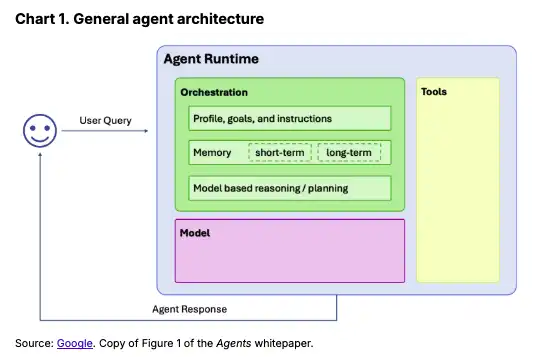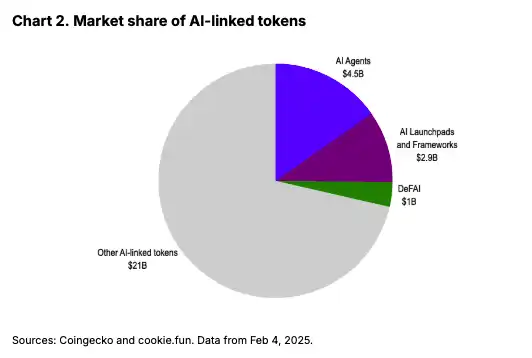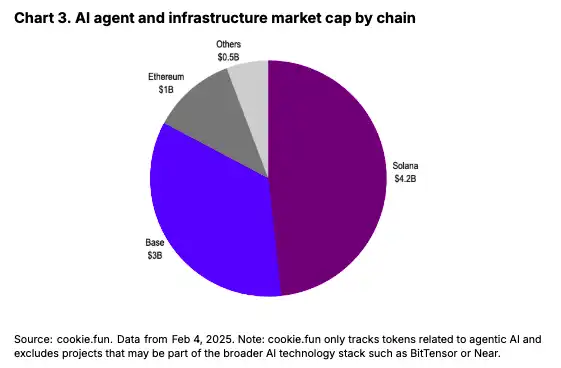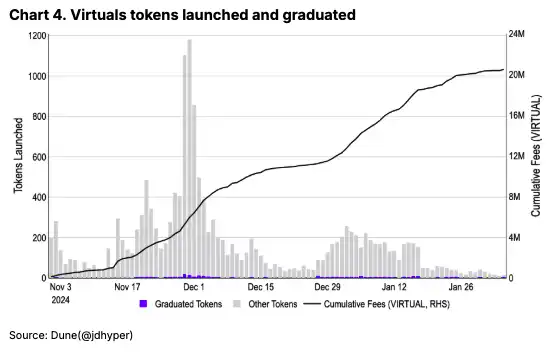Original title: Advancing Agency AI
Original authors: David Han, David Duong, Coinbase
Compiled by: Deng Tong, Golden Finance
abstract
·Artificial intelligence agents have become one of the most promising narratives in the field of artificial intelligence x encryption, but due to the rapid development of technology and the proliferation of agents, the field is still in its infancy and difficult to control.
·Investor interest in AI agents is mainly reflected in two aspects-the core infrastructure for launching and hosting agents, and the individual agents themselves.
·We believe that due to the continuous enrichment of functions in the field of artificial intelligence agents in the field of encryption, there is huge room for growth in the future. However, at least for now, expectations for artificial intelligence agents may exceed developments in the technology itself.
AI proxies have become a revolutionary theme not only in the realm of encryption, but also in the broader field of technology. The concept of autonomous entities capable of analyzing market news sources or other external data and making real-time decisions has captured the imagination of many institutional investors. Elsewhere, some technology industry leaders believe thatAI agents may eventually replace the huge software-as-a-service (SaaS) industry. In other words, a well-trained AI agent can in principle complete any task involving digital interfaces.
We believe thatCryptography tracks can play a central role in the future, becoming the main value transfer mechanism for AI agents。The inherent programmatic nature and permissionless design of encryption support the expansion and deployment of an almost unlimited number of such agents, enabling a wider range of use cases from managing portfolios along the chain to paying for offline services. Given this potential opportunity, the market value of proxy AI crypto assets peaked at more than $20 billion in early January, and then approached $8 billion at the end of the month.
The recent decline may indicate that expectations of AI agents have begun to exceed actual developments in the technology itself.While we expect this theme to change the Crypto x AI landscape in the long term, its short-term application is limited by integration and proxy differentiation challenges, as well as uncertainty about the long-term utility of proxy tokens. In other words, realizing the full potential of artificial intelligence agents may take longer than many people think.
Understanding Differences: Agents and Models
Many popular AI tools, including chat interfaces such as ChatGPT or image generators such as Stable Diffusion, are wrappers for generative AI models. They are defined by a bounded set of inputs and outputs, usually in the form of text, audio, and images. AI agents extend the direct functionality of these models by introducing a new class of applications that represent “a combination of reasoning, logic, and access to external information”(according to Google’s definition).
Specifically, AI agents can access and interact with a wider range of data and tools, allowing them to drive more complex behaviors, from searching multiple databases to planning travel and booking flights. With on-chain wallet integration, the scope of AI proxy activities has been greatly expanded by including payment services into its toolkits.

Crucially, AI agents can also use their reasoning capabilities to act autonomously in dynamic environments.The triggers of AI agents are not limited to manual user prompts-they can be concurrent based on various data streams, including X (formerly known as Twitter) posts or Twitch chats. Likewise, their responses can include multi-step outputs, such as placing an order, making payments, and sending confirmations to interested parties.
Agents typically consist of ( 1) the core LLM model as their inference engine,( 2) short-and long-term memory components,( 3) potential roles or personality frameworks, and ( 4) most importantly, the ability to access the wider Internet and other tools through application programming interfaces (APIs). As a result, decisions made by agents can directly affect the real world.
AI agents are ushering in a major explosion
The infrastructure and tools surrounding AI agents are rapidly evolving, becoming one of the most watched technology trends over the past year.。Multiple developer frameworks used to build AI agents (including but not limited to CrewAI, LangGraph, AutoGen, phidata, Atomic Agents, AgentGPT, and AutoGPT) are competing for market adoption, and the top 15 code repositories on Github in January 2025 are also related to artificial intelligence.
The attention and excitement about artificial intelligence and its proxy applications has extended to artificial intelligence-related tokens in cryptocurrencies.Most of the recent growth in token value since the fourth quarter of 2024 has been related to proxy AI themes, which currently account for 29% of the value of all AI-related crypto tokens. In the proxy AI ecosystem, proxy tokens account for the majority of valuations, accounting for a market value of $4.5 billion, while according to cookie.fun, a platform that tracks AI agents in the crypto space, the market value of tokens associated with launch boards and frameworks is $2.9 billion.

We believe thatThe excessive focus on agents relative to their underlying infrastructure is driven in part by the memetic nature of many “agents”, which is consistent with the increase in memin activity observed during most of 2024.。In fact, one of the first AI-related tokens to go viral became famous because it was recognized by the AI agent that operated the famous X account truth_terminal (now has more than 250,000 fans), rather than having an underlying project or governance structure associated with it.
That being said, some AI proxy tokens provide more utility by granting access to token-gated chat terminals or services, where agents can provide differentiated perspectives on various topics, such as crypto market conditions. At the same time, in our view,AI infrastructure tokens are often based more on revenue from specific projects and are often used to pay fees and governance。
So far, most AI agents, launch boards, and other infrastructure have found home on high-throughput and low-cost blockchain-especially on Solana and Base. Solana accounted for US$4.2 billion in the market value of proxy AI tokens, Base accounted for US$3 billion, and the remaining chains accounted for a total market value of US$1.5 billion. We believe this is in part because low-cost architecture is necessary to support the widespread popularity of AI agents. In addition, we believe that the strong developer ecosystem formed along the leading chain drives a virtuous cycle of idea sharing and adoption.

Competing for investor psychological share: Social influence
There are several leading agents in the current AI agent field that have begun to dominate the field. Aixbt, the most prominent AI agent to date, has gained attention by operating an X account (now with more than 465K fans) dedicated to interacting with a crypto audience on the platform. It has a token-gated terminal where users holding a sufficient number of project tokens can access a dedicated chat space with the agent, allowing them to privately access their real-time “thoughts”.
Other leading agents, such as Zerebro (with 119K fans), follow a similar pattern, using prominent social media profiles to gain attention in the field. Zerebro is particularly focused on on-chain art generation. Its native tokens can be used to pay for creating images, while its chat terminals are controlled by the NFT.
However, not all proxy AI tokens have a practical appearance. One of the top AI tokens in terms of attention (tracked by cookie.fun) is Fartcoin, whose idea was conceived through a conversation with the truth_terminal AI agent mentioned above. That is, the origin of the token itself is related to AI agents, although the long-term utility of the token itself remains unclear beyond the importance of memes.
We believe thatThe interaction between memes and the token utility of AI agents attracts traders in all fields, from speculators to value investors。That being said, given the rapid development of the field, we believe the ultimate scope and capacity of any individual token remains largely unknown. That is to say,Whether memecoins associated with AI agents will develop beyond pure speculation and/or show any utility beyond community governance or access-gating remains an open question.。We will discuss this further in the Risks and Future section below.
Follow funding: launch platforms and infrastructure
After becoming one of the best-performing cryptocurrency segments in November and December 2024, artificial intelligence proxy tokens took a significant hit in January 2025, in part because the market became severely saturated in such a short period of time. This led to some market consolidation. Since many of these tokens compete directly with memecoin in the attention economy of cryptocurrencies, it remains difficult to plan for value accumulation in this space. In the short term, we find that direct agreement revenue is often concentrated on the transaction interfaces and launch boards where AI proxy tokens are deployed, rather than on the tokens themselves, despite their relatively small total market capitalization.
On Base, Virtuals Protocol has been the leading artificial intelligence launch platform, supporting simplified launch of artificial intelligence agents and tokens in games and various application areas. (Note: Virtuals announced its expansion to Solana on January 25.) You can create a Virtuals agent without any coding. Users only need to fill out a simple form and spend the required number of Virtuals platform tokens. After submission, the baseline agent will be initialized on the Virtuals infrastructure, while relevant tokens will be minted on the chain. Initially, tokens are deployed in a binding curve and are transferred to the Uniswap pool once a certain liquidity threshold is reached. (Note: This has some similarities to the token release on pump.fun and its transfer to the Raydium pool.)
To date, nearly 16,000 proxy tokens have been launched on Virtuals, and more than 20 million Virtuals tokens have been generated for fees. That said, the number of agents launched has declined in the past few weeks, from a one-day peak of 1181 to an average of 31 in the last week of January. In addition, the number of tokens with sufficient liquidity has dropped to an average of one or two per day. Overall, of the 15,985 coins launched, only 334 (2%) reached sufficient liquidity to transfer to the Uniswap pool, indicating that competition for attention and capital is fierce.
We believe that the main reason for this decline is the difficulty of creating new agents that are sufficiently differentiated from existing agents. While Virtuals agents can be customized within their cognitive, voice and visual cores, parsing changes between agents launched on Virtuals has become an increasingly difficult task-in line with thought-sharing competition such as memecoins. Still, we believe that as AI agent integration expands and use cases are further explored, launch boards like Virtuals will play a key role in the proliferation of agents in this ecosystem. In fact, the aixbt mentioned earlier was launched on Virtuals.
The main alternative to the Virtuals launcher is the ElizaOS proxy framework. Unlike the streamlined deployment of mature launch boards, agent developer frameworks like ElizaOS only provide the technical scaffolding needed for agent construction. That is, more technology-oriented agent creators can use ElizaOS to launch highly customized agents on different blockchain networks, because model hosting, verification, and other engineering tasks are left to the creators. That being said, AI proxy hosting companies like Fleek also support code-less deployments based on ElizaOS-based models.
As a pure AI agent development framework, ElizaOS has no native tokens. However, the ai16z governance token on Solana (now renamed ElizaOS token) is often seen as a proxy for the adoption of the technology because Shaw Walters, the creator of the ai16z Decentralized Autonomous Organization (DAO), is the founder of Eliza Labs, which oversees the development of ElizaOS. The ai16z DAO itself manages investments on and off the chain, and AI fund managers (built using the ElizaOS framework) manage transactions and positioning.

The ElizaOS framework is particularly worth mentioning that its code base has been attracting much attention since its release-at one time becoming the hottest repository on Github. If developers feel that a project is particularly influential, they can choose to “star” the repository, just like liking photos or posts on social media.
The stars ElizaOS has gained make it quite competitive with many other leading AI proxy frameworks, including frameworks launched by technology giants such as Microsoft. (See Figure 3.) We believe this suggests that the broader software engineering community has a real interest in the intersection of AI agents and on-chain activities, which is ElizaOS’s core distinguishing feature as an AI agent framework.
In addition to Virtuals and Eliza, many other AI proxy frameworks and launch boards have surfaced and found their own niche markets. For example, Griffain aims to create a network of agents tailored to DeFi activities. At the same time, what distinguishes the Arc proxy framework is that in addition to being built using Rust, its design is more lightweight and modular. We expect this area to grow rapidly as these frameworks develop and new frameworks are adopted.
Risks and the Future
Also, we believe thatAs more capital flows begin to shift to DeFAI (decentralized finance + artificial intelligence) and/or other infrastructure, the decline in AI agent performance in January may signal an early maturity of the industry.
DeFAI represents a combination of artificial intelligence and encryption technology to enhance various DeFi functions.Benefits include the ability to run automated revenue farming strategies and use predictive algorithms for better risk management and fraud prevention. As many DeFi protocols begin to become rigid, the integration of artificial intelligence functions with existing ecosystems can drive new innovations. Over time, the industry is expected to cultivate new financial products and expand the scale of many DeFi platforms by using the computing power of artificial intelligence.
However, at present, in addition to checking access and promoting governance, the long-term utility of artificial intelligence proxy tokens is unclear. The reality is thatAlthough AI agents have made significant progress very quickly, we have not reached the point where fully autonomous AI agents can handle complex real-world tasks without any supervision.。Their current reliability is still limited and costs remain unreasonably high. Many AI agents also cannot consistently handle data verification issues, which may raise legal issues or affect user confidence.
Still, continued breakthroughs such as the emergence of the DeepSeek R1 model-which itself focuses on advanced “reasoning” tasks-could overturn concerns about speed-cost ratios. In fact, these models are developing rapidly, with accounting firm Deloitte predicting that within two years, half of all companies currently using generative AI could launch AI agents.
Ultimately, the transformative vision is that we may have a multi-agent system in which autonomous AI agents strategically collaborate and/or compete to optimize more complex results than currently possible. However, the new life in the field makes forecasting challenging. In addition, large technology companies like OpenAI have only recently begun releasing their early AI agents, and we expect more companies to follow suit soon.The development of centrally managed AI agents-which may be integrated into traditional payment tracks-may also have disruptive factors in the adoption of AI agents on the chain.We believe that development in this field will be extremely dependent on pioneers and early adoptions of flywheels.
conclusion
Over the past few months, AI proxies have been one of the topics with the most attention and trading opportunities among liquidity tokens. Although the valuations of many major tokens have fallen significantly from record highs (witnessed in early January), we believe that in the long term, developer interest and capital inflows into the space could provide a significant boost to the industry as a whole.
But at the same time, we believe thatSince both cryptocurrencies and the broader technology field can cause interference in this area, it may be premature to predict the long-term value capture of AI tokens. In addition, we believe that the current on-chain utility of agents may not be enough to ensure that there are thousands of highly utilized agents in the short term.Despite this, we believe that this area remains an important topic worthy of attention due to the rapid pace of innovation and high long-term potential.
original link



